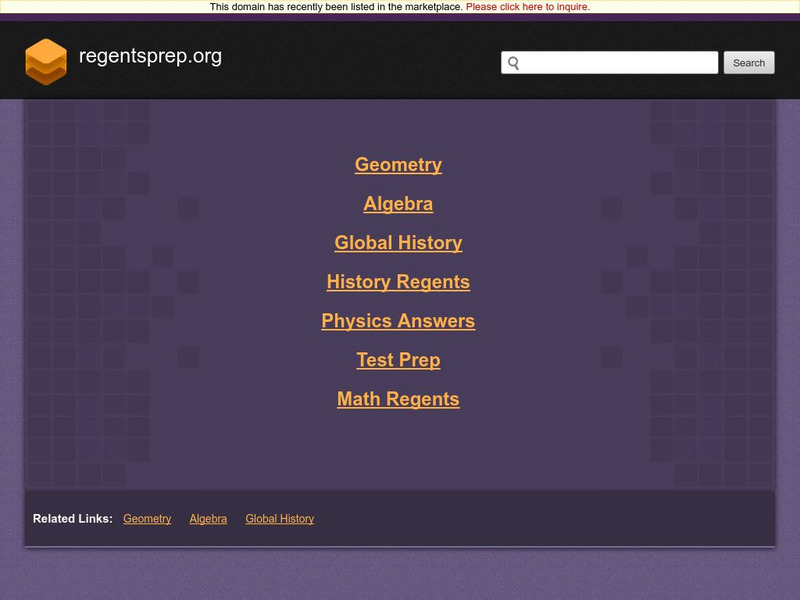Hi, what do you want to do?
Curated OER
Geometry and Quilting
Fourth graders combine geometry and language arts skills while examining quilt-making. After identifying the geometric shapes contained in quilts, they write stories to encompass the quilt border. Students conclude by creating and...
Curated OER
Worksheet 2: Games
In this games instructional activity, students read four descriptions of different indoor games of the world. Students guess the name of each game and write it in the space after the description. There is a word bank.
Curated OER
Pythagorean Triples
Middle schoolers investigate the mathematical concepts related to the study of The Pythagorean Theorem. They graph and review how to use a line segment to construct a triangle. Then using the theorem students calculate the length of the...
Curated OER
Measuring Angles
Third graders describe an amount of turn from a particular position to another using the 'circular' benchmarks of 0, ++, ++, ++, and full turn. Estimation language such as 'just about', 'between', 'not quite', 'just over', and similar...
Curated OER
Solving Problems Using Quadratic Equations
In this math worksheet, students solve the problems using quadratic equations for each word problem. The example is used for reference.
Curated OER
SAT Prep
In this secondary mathematics learning exercise, students are provided with questions that are designed to provide SAT test preparation. The one page interactive learning exercise contains ten questions. Answers are not provided.
Curated OER
SAT Practice Test
In this online, interactive instructional activity, students solve ten SAT preparation problems in 12 minutes. The problems vary in difficulty and content.
Curated OER
6th Grade Math Worksheet
In this multiple task math worksheet, 6th graders solve 10 math problems involving metric units, number lines, composite numbers, estimation and percentages.
Curated OER
SAT problem solving practice test
In this online, interactive worksheet (7), students complete ten problems in 12 minutes to help prepare then to take the SATs. The problems vary in difficulty and content.
Curated OER
Line and Shading = Shape and Form
Students collect natural objects and draw these objects with and without shading.
Curated OER
Calculating the Shortest Distance Between Two Points
Ninth graders calculate the distance between two points.
Curated OER
Introducing Powers and Models
Students construct two dimensional models to illustrate squared numbers. In this geometry instructional activity, students use graph paper and an x/y axis to build squares exponentially. Students identify powers and relationships between...
Curated OER
Vocabulary Challenge
In this math vocabulary worksheet, students choose which multiple choice answer best defines twenty-five mathematical terms. Students place their answers on the lines provided.
Curated OER
Quilt Squared
Students study West Virginia quilts. For this mathematics lesson, students use symmetry, geometric shapes, and patterns to create their own quilt square.
Curated OER
My Test Book: Geometry
In this online interactive math skills worksheet, learners solve 10 multiple choice math problems regarding geometry skills. Students may view the correct answers.
Curated OER
I Belong, But Why Don't You?
Pupils explore discrimination. In this character development lesson, students identify groups and organizations to which they belong and the requirements that go with each group. Pupils discuss inclusion and exclusion and generate ideas...
Curated OER
Entry 1 Numeracy Practice--B
In this numeracy practice learning exercise, students answer thirteen word problems by following the directives given as they read through each one.
Cuemath
Cuemath: Right Angled Triangle
Explore and learn about the features and properties of a right triangle in this lesson. Includes examples and practice questions.
CK-12 Foundation
Ck 12: Trigonometry: Alternate Formula for the Area of a Triangle
[Free Registration/Login may be required to access all resource tools.] An alternate formula for the area of a triangle.
Oswego City School District
Regents Exam Prep Center: Area of a Triangle and Parallelogram Using Trig
How can trigonometry be used to find the area of a triangle or parallelogram? Does the triangle need to be a right triangle, and how accurate can the results possibly be? The answers to these questions are found here along with several...
Mathigon
Mathigon: Geometry: Triangles and Trigonometry: Properties of Triangles
This lesson focuses on the properties of triangles, a closed shape that has three sides, three vertices, and and three internal angles. There are different types of triangles such as a right triangle, obtuse, and acute based on the...
University of Georgia
University of Georgia: Inter Math: Recommended Investigations of the Triangle
Investigate the qualities of a triangle with these seventeen word problems. Many include ways to extend the lesson.
Homeschool Math
Homeschool Math: Area of Parallelograms
This lesson presents the idea that the area of any right triangle is exactly half of a certain rectangle, and contains varied exercises for learners.
Shodor Education Foundation
Shodor Interactivate: Triangle Explorer
This applet allows users to study the nature of triangles and their area. It draws random triangles on a Cartesian coordinate system. The user can determine the area of the triangle using his or her preferred method. After the calculated...

























